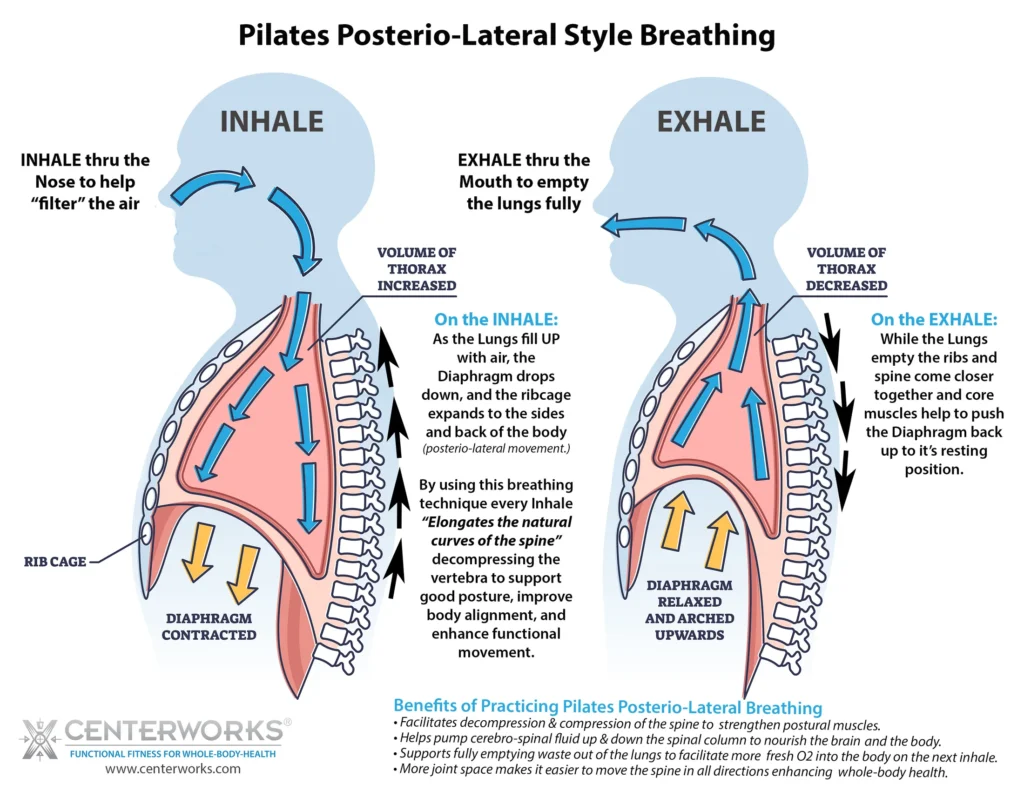
How to Use Posterio-Lateral Breathing Techniques to Enhance the Benefits of Your Pilates Practice and Improve Whole-Body Health
Are you ready to maximize the benefits of your Pilates practice? The role that breathing plays in Pilates has a big impact on the benefits you get from every exercise in your workout. Pilates Posterio-Lateral Breathing has some magical qualities to help enhance your whole-body health and help improve how you move.
It’s great that we don’t have to consciously think about every breath we take to say alive but its wonderful to notice how much paying attention to your breathing technique can significantly improve your well-being. Breathing is one of several key movement principles in Pilates. And in truth, it is probably the most important aspect of improving movement and fine-tuning your Pilates exercise technique. For healthy movement habits our exercises should “ride the breath.” This means that every exercise has a breathing pattern that will best support executing the movement efficiently.
How you “ride the breath” for efficient breathing in Pilates, and how many breaths you take on each exercise can change based on your level of Pilates experience. Beginner Pilates students move a bit slower through their exercises – as there are so many parts of the body to be aware of, pay attention to, and coordinate while you’re moving through a Pilates workout. Once you get the basics under your belt, it becomes easier to naturally “pick up the pace.” When this happens, the breath pattern for your exercises will change to make it easier to move more quickly and still “ride the breath” for efficiency.
Breathing in Pilates is very different than any other style of breathing (and there are many!) In my opinion, the way breathing in Pilates is taught makes it the most effective, and natural way to breath for body support to open joint space, enhance posture, and improve core support. IF everyone were to use this style of breathing for all their activities, sports, and chores for daily living, there would be a huge shift in wellness, with people enjoying fewer aches and pains, and an increase in ease of movement.
I’ve written quite a few articles over the years about Pilates breathing, because it really is a key to unlocking better health. The Pilates method does a brilliant job of utilizing breath. If you’re paying attention and have a Pilates teacher that can help you hone in on how to change your habits to make your breathing in Pilates better, it will be life-changing to improve your health.
Why is Breathing in Pilates Important?
Breathing is an essential part of Pilates because it helps to oxygenate the body and keep the mind and body connected. Breathing in Pilates done effectively provides a way to constantly decompress and compress the spine in a healthy way that not only opens joint space to allow freer movement, but also helps to “pump” nourishing cerebral spinal fluid up and down the whole spine from your tailbone to the top of your head. The “work and release” that happens with this decompression/compression action helps activate and relax muscles, which allows for more controlled and efficient movement.
How you breathe matters. The timing of when you inhale, and when you exhale matters. And where you put the air into your body on every Pilates exercise matters to help maximize both the stability and mobility needed to improve how you move.
What Happens with Poor Breathing Habits?
- When you hold your breath, you hold your body in tension and restrict movement. Exercises end up being more of a tug of war effort, rather than smooth and efficient movement.
- When your abs pooch out to the front as you inhale (typically how people are taught to do “diaphragmatic” breathing) you lose all the support for your lower back, and it can increase low back and hip pain problems.
- When you take a high front chest breath, it’s too shallow, you cannot get enough oxygen into your system to nourish your body, your breathing is more rapid, AND because the air is going high in the front, it’s pulling your upper back out of alignment, which can also cause low back pain problems, as well as upper back pain, shoulder, arm, and neck pain issues.
The Benefits of Breathing in Pilates with Pilates-style Posterio-Lateral Breathing Techniques
There are so many great benefits to incorporating proper breathing techniques into your Pilates practice. The Pilates-style posterior-lateral breathing method, while it might feel strange to learn, will make everything you do easier, and healthier once you master the technique. Do you need to breath this way all the time? Not necessarily… If you are resting, or sleeping, or meditating there are other breathing techniques that may be more useful. But if you are up and around, moving through daily life activities, or doing any type of vigorous sport or exercise, being able to apply the same posterior-lateral breathing technique that you practice in Pilates will help improve the ease and performance of what you’re doing.
Some of the Benefits of Breathing this Way Include:
- Better Posture and Body Alignment. Pilates posterior-lateral breathing helps elongate and support the spine on your inhale and provides better core support on your exhale. Practice breathing in Pilates and take what you’re learning out the door to your daily life and you’re reinforcing your Pilates-improved posture and using Pilates breathing to help maintain whole-body health.
- Improve Focus and Concentration. Paying attention to your breathing helps to keep the mind present and focused on the task at hand. This improves concentration, and helps you fine-tune your exercise technique. (It’s practically impossible to think about other stressors in your life, or things you need to do later, when you’re focused on breathing and doing the exercise in your Pilates workout.)
- Enhance Physical Performance. Proper breathing helps to oxygenate the body, which can improve endurance and physical performance. It can also help to relax the muscles when needed to improve range of motion. By “riding the breath” and moving more efficiently, there is a reduced risk of injury which compliments improved physical performance.
- Increase Relaxation and Reduce Stress. Focusing on breathing in Pilates can help to calm the mind and reduce stress. This can lead to a more enjoyable workout and helps cue the body to want to spend more time in this energized and supported, yet relaxed state of being.
The role of breathing in Pilates is a crucial part of the Pilates Method to improve whole-body health. Practicing proper breathing techniques can help improve posture, reduce stress, support functional movement, help eliminate aches and pains, enhance focus, and increase physical performance. By incorporating better breathing into your Pilates workouts (and learning how to take your Pilates breathing habits and muscle memory out the door into the rest of your life,) you can maximize the benefits of your Pilates workouts and ensure that your Pilates practice is not just “exercise” but a life-enhancing part of your week to empower wellness for mind, body, and spirit.


0 Comments